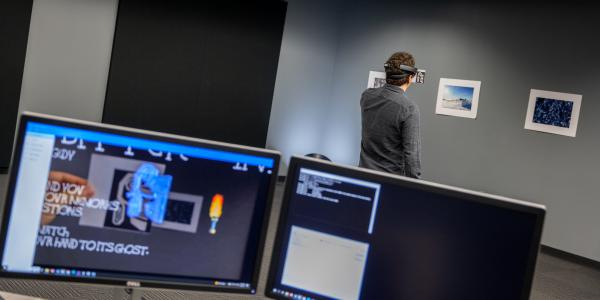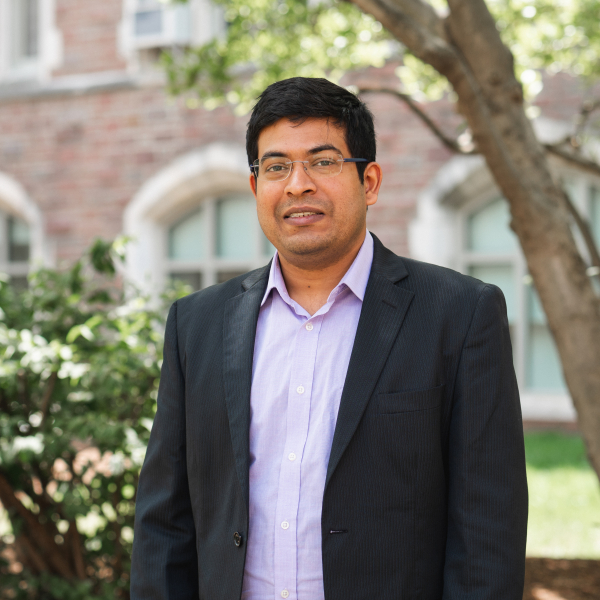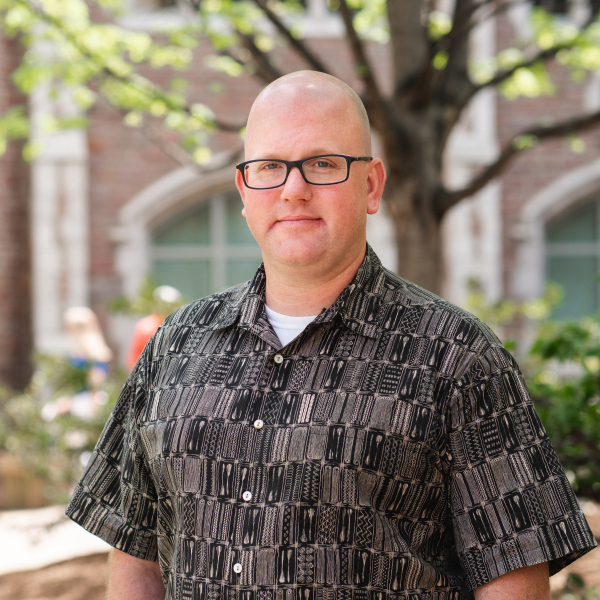As part of the Incubator for Transdisciplinary Futures, faculty members across Arts & Sciences are working together to decode the relationship between technology and the mind.
Can artificial intelligence help us better understand the mechanics of the human brain?
How can educators deploy virtual and augmented reality in the classroom?
What does modern mindfulness look like in a screen-driven society?

Faculty members across Arts & Sciences are collaborating to answer these questions and more as part of the Incubator for Transdisciplinary Futures (ITF), a signature initiative of the Arts & Sciences Strategic Plan.
“The Incubator for Transdisciplinary Futures is about supercharging novel and wild collaborations to pursue transformative research, design new learning experiences, and show us pathways for the university of the future,” said William Acree, co-director of the initiative with Betsy Sinclair. “It provides an incredible institutional framework for such innovation across Arts & Sciences, as well as across the university.”
Among the 14 research teams currently funded by ITF, three multiyear clusters are addressing an increasingly critical issue: the relationship between technology and the mind. Drawing on the expertise of several disciplines, researchers are exploring the nature of human understanding, the exciting (and frightening) future of immersive technology, and the renewed relevance of an ancient technology of perception.
“The faculty members working on these projects epitomize our values of convergence, creativity, and community,” said Feng Sheng Hu, dean of Arts & Sciences. “ITF positions Arts & Sciences to be a leader in transdisciplinary research and paves the way for groundbreaking educational opportunities.”
Toward a Synergy Between Artificial Intelligence and Neuroscience
Pull up a list of academic departments, and you’re likely to see the natural sciences split into subdisciplines. But that hasn’t always been the case, said Ralf Wessel, professor of physics.
“What we now call physics, chemistry, and biology were once called ‘philosophy of nature’ — a united human effort to understand nature,” he said.
As the rapid development of artificial intelligence challenges the very concept of human understanding, Wessel believes that reuniting the sciences is a crucial step in defining biological intelligence.
“In science, we often think that we understand something when we can create statistical relations between data. But that type of understanding is identical to what AI is doing today — often more effectively than humans,” Wessel said. “As a community, scientists must address the growing question: What exactly is biological intelligence?”
To help answer this question, Wessel is spearheading the cluster “Toward a Synergy Between Artificial Intelligence and Neuroscience” with Keith Hengen, assistant professor of biology, and Likai Chen, assistant professor of math and statistics. Through transdisciplinary research comparing artificial and biological intelligence, they aim to develop a better understanding of both.
“Over the last few decades, the models underlying AI were inspired by what we know about neurons in the brain,” Wessel said. Recently, however, AI models have become so successful that scientists are wondering if the relationship between neuroscience and computer science can be reversed: Can AI models help us understand how computations are done in the brain?
As a community, scientists must address the growing question: What exactly is biological intelligence?
“Like the brain, AI models that perform human tasks are incredibly complex,” Wessel said. “But unlike the brain, where only a tiny fraction of the underlying mechanics are accessible, we have access to all of the information involved in making AI models work. So, we’re looking to use these models as steppingstones to understanding the brain.”
Wessel’s own research produced a compelling example of this approach. Using nature documentaries, Wessel and physics graduate student Zeyuan Ye trained an AI model to predict the next frame of a video. They then exposed this model to a static image, observing what concepts the model used to predict how the image would change. The team also tracked brain activity from mice exposed to the same image, allowing them to compare artificial and biological approaches to a similar problem.
“At a high level, we see conceptual similarities in how the AI model and the mice performed this task of ‘seeing the world,’” Wessel said. Working from similar statistical links between images, the artificial and biological “minds” looked alike.
Wessel hopes that learning more about the conceptual mechanics of AI models could have applications in other areas, like treating brain disease. More immediately, he thinks an improved understanding could help chart a more responsible trajectory for AI.
“One of the bottlenecks to making AI better is a lack of understanding about how these models actually work,” he said. “If we can contribute to a deeper understanding of those mechanics through this cluster, that will be a great practical improvement.”

Immersive Technology Collective
“Someday — maybe soon — machines will be reading books and turning them into virtual reality,” said Seth Graebner, associate professor of French and global studies.
To some literature enthusiasts, that prediction might sound disturbing. To Graebner, however, it is a call to action. “I believe that humanists should be involved in virtual and augmented reality from the beginning,” he said. “That way, we can develop enough understanding and expertise around this technology to have some say in how it is deployed.”
Through the “Immersive Technology Collective” (ITC), Graebner is working with Elizabeth Hunter, assistant professor of drama, and Uluğ Kuzuoğlu, assistant professor of history, to promote creative applications of virtual and augmented reality across campus. “We want WashU to become a leader in this emerging space,” Hunter said.
Broadly speaking, the collective focuses on digital experiences that have broken out of a screen and into the physical environment, Hunter said. Having used such technology in her own research and pedagogy, she knows how exciting its applications can be.
“I’m interested in the way augmented reality (AR) emphasizes the user’s embodied presence while layering elements of the past onto their physical surroundings,” she said. Her latest project will use mobile AR to bring family memories into the present for patients with Alzheimer’s disease and dementia.
Kuzuoğlu, meanwhile, is developing a completely immersive virtual reality (VR) project that will allow his students to experience what it would have been like to walk along the cosmopolitan waterfront in Canton, China, in the 19th century.
“We are excited to see what faculty do with these tools once they become more familiar,” Hunter said. “Immersive technology will open up new ways of thinking across disciplines.”
The collective, which evolved organically from ongoing collaborations within the Fossett Lab for Virtual Planetary Explorations, has already helped faculty in departments ranging from chemistry to art history explore ways to integrate AR and VR into their teaching and research, and they’re only just beginning.
Immersive technology will open up new ways of thinking across disciplines
“In our experience, most fields have at least one person who wants to use immersive technology, but that person may not have the necessary resources,” Graebner explains. “We’re working to change that.”
Starting in the fall of 2023, the cluster will invite industry experts to host training sessions for faculty interested in using immersive devices like Microsoft HoloLens.
In the future, the ITC hopes to create a campus center for immersive technology that would host AR and VR technology and specialists, and where faculty could meet and discuss their work. As ITC members have already experienced, the opportunity to have such conversations can spur new developments.
“Speaking across disciplines to faculty who already understand how the technology works can provide a lot of insight into your own projects and even initiate transdisciplinary collaborations,” Hunter said.
The cluster also hopes to develop certification programs for students interested in working in immersive technology. These programs would emphasize ethical considerations in the burgeoning industry while also preparing students for job opportunities.
“We don’t want our liberal arts students to just point out when the technology is being misused,” Hunter explained. “We want them to play an instrumental role in creating and using this transformative technology.”

Mindfulness Science and Practice
In his Olin Business School course “Mindfulness and Performance in the Workplace,” Erik Dane and his students explore the benefits of putting down their smartphones and paying attention to the world around them through a range of experiential learning activities. “That’s been quite rewarding in a day and age where we’re bombarded by more distractions than ever,” said Dane, associate professor of organizational behavior.
To Dane and the other leaders of the “Mindfulness Science and Practice” cluster, the ancient practice is a promising solution to the growing mental health crisis among students and young people. “Mindfulness is a technology which may help address mental health problems without requiring money or medication,” said Ron Mallon, chair and professor of philosophy-neuroscience-psychology. “It has the potential to do a lot of good in the world.”
But even mindfulness, a 2,500-year-old practice of meditative perception, can be turned into a watered-down commodity. “I saw an ad for mindful hamburgers recently. I’m not sure what that meant, but mindfulness is everywhere now,” said Todd Braver, professor of psychological and brain sciences. “In that context, we want to promote a more substantive understanding of the practice.”
To do this, the cluster is planning a seminar on how mindfulness has been adapted in modern Western culture, and it has already initiated a lecture series highlighting the role of mindfulness in anti-racism efforts. The group is also planning an international scientific conference, a “Mindfulness Day” on campus, and an undergraduate minor in mindfulness science and practice.
The ability to work and share ideas across disciplines has been invaluable. “As a group, we can generate dialogues and engage in collaborative research that none of us would have come up with on our own. We can inspire each other,” Braver said.
Braver and Diana Parra, research assistant professor in the Brown School, worked together to convene the cluster after recognizing that there were people in various corners of the university who shared their passion for incorporating mindfulness into teaching, research, and personal practice.
“My interest in mindfulness came from using it as a way to cope with stress from work,” Parra said. “Over time, it started merging with my teaching. I now begin all of my classes with a short meditation practice.”
Braver also found and published quantitative evidence that his seminar, which teaches mindfulness to first-year students, helped improve their performance and stress levels.
Parra believes that the “technology” of mindfulness is more relevant than ever in the wake of the COVID-19 pandemic. “During COVID, everybody was forced to pause,” she said. “In that moment where you stop and take a break from everything — which is what you do in meditation — a lot of things rise to your conscious awareness that you might not be equipped to deal with. Mindfulness offers a tool for you to develop more compassion for yourself in those moments.”
According to the leaders of the cluster, mindfulness is a unique topic where ancient cultural traditions are in agreement with cutting-edge science. “There is a rapidly growing body of evidence indicating that mindfulness is one of the best tools we have for understanding ourselves and the people around us,” Braver said. “Hopefully, we can use that understanding to reduce biases and make the world a better place.”
Additional Faculty Collaborators
Immersive Technology Collective: Seth Graebner (Global Studies), Elizabeth Hunter (Performing Arts — Drama), Kristina Kleutghen (Art History and Archeology), Uluğ Kuzuoğlu (History), David Marchant (Performing Arts — Dance), Rob Morgan (Performing Arts — Drama), Phil Skemer (Earth and Planetary Sciences)
Toward a Synergy Between Artificial Intelligence and Neuroscience: Todd Braver (Psychology), Likai Chen (Math & Statistics), Yixin Chen (Computer Science), ShiNung Ching (Electrical & Systems Engineering), Carl Craver (Philosophy), Tom Franken (Neuroscience), Geoffrey Goodhill (Developmental Biology), Keith Hengen (Biology), Erik Herzog (Biology), Brendan Juba (Computer Science), Zohar Nussinov (Physics), Linda Richards (Neuroscience), Gaia Tavoni (Neuroscience), Ralf Wessel (Physics), Jeff Zacks (Psychology)
Mindfulness Science and Practice: Todd Braver (Psychological & Brain Sciences), Erik Dane (Olin Business School), Armando Gomes (Olin Business School), Callista Isabelle (Director for Religious, Spiritual and Ethical Life), Eric Lenze (Psychiatry, School of Medicine), Yanli Lin (Psychological & Brain Sciences), Ron Mallon (Philosophy), David Marchant (Performing Arts — Dance), Diana Parra (Brown School of Social Work), Kerri Rawson (Physical Therapy), Tom Rodebaugh (Psychological & Brain Sciences), Chris Rozek (Education), Erin Stampp (Diversity, Equity, and Inclusion), Atia Thurman (Brown School of Social Work), Andy Wiegert (Director of Graduate Student Affairs)
Learn more about the Incubator for Transdisciplinary Futures, including the faculty leads for the multiyear clusters and the programmatic grants.




